List of asanas
An asana is a body posture, used in both medieval hatha yoga and modern yoga.[1] The term is derived from the Sanskrit word for 'seat'. While many of the oldest mentioned asanas are indeed seated postures for meditation, asanas may be standing, seated, arm-balances, twists, inversions, forward bends, backbends, or reclining in prone or supine positions. The asanas have been given a variety of English names by competing schools of yoga.[2]

The traditional number of asanas is the symbolic 84, but different texts identify different selections, sometimes listing their names without describing them.[3][lower-alpha 1] Some names have been given to different asanas over the centuries, and some asanas have been known by a variety of names, making tracing and the assignment of dates difficult.[5] For example, the name Muktasana is now given to a variant of Siddhasana with one foot in front of the other, but has also been used for Siddhasana and other cross-legged meditation poses.[6] As another example, the headstand is now known by the 20th century name Shirshasana, but an older name for the pose is Kapalasana.[3][7] Sometimes, the names have the same meaning, as with Bidalasana and Marjariasana, both meaning Cat Pose.[8][9]
Affixes
Variations on the basic asanas are indicated by Sanskrit affixes including the following:
| English | Sanskrit | Meaning | Example |
|---|---|---|---|
| Adho | अधो | downward | Adho Mukha Shvanasana (downward dog) |
| Ardha | अर्ध | half | Ardha Padmasana (half lotus) |
| Baddha | बद्ध | bound | Baddha Konasana (bound angle) |
| Dvi | द्वि | two | Dvi Pada Kaundinyasana (two-legged Kaundinya) |
| Eka | एक | one | Eka Pada Shirshasana (one-legged headstand) |
| Parivritta | परिवृत्त | revolved | Parivritta Trikonasana (reverse triangle) |
| Prasarita | प्रसारित | spread out | Prasarita Padottanasana (wide stance forward bend) |
| Salamba | षलम्ब | supported | Salamba Shirshasana (supported headstand) |
| Supta | सुप्त | supine, reclining | Supta Virasana (reclining hero) |
| Upavishta | उपविष्ठ | seated | Upavishta Konasana (wide-angle seated forward bend) |
| Urdhva | ऊर्ध्व | upwards | Urdhva Dhanurasana (upwards bow) |
| Utthita | उत्थित | extended | Utthita Parsvakonasana (extended side angle) |
| Viparita | विपरीत | inverted | Viparita Dandasana (inverted staff) |
Asanas
A single asana is listed for each main pose, whether or not there are variations. Thus for Sirsasana (Yoga headstand), only one pose is illustrated, although the pose can be varied by moving the legs apart sideways or front-and-back, by lowering one leg to the floor, by folding the legs into lotus posture, by turning the hips to one side, by placing the hands differently on the ground, and so on. Iyengar's 1966 Light on Yoga lists 15 variations on the basic headstand, including for instance the combined variation Parivrttaikapada Sirsasana in which not only are the hips revolved but the legs are apart front-and-back.[10] Since then, variations of many other poses have been created; their names are not listed here.[11] Yin Yoga names are for the equivalent Yin variants; these are usually somewhat different from the conventional (Yang) poses.
Indian texts are "notoriously difficult to date".[12] The table shows the approximate date and abbreviated title of the earliest document or authority to describe that asana (not only naming it), as follows:
- AS = Ahirbudhnya Saṃhitā, c. 7th century
- BaH = Bahr al-Hayāt, 17th century
- DU = Darśana Upaniṣad, c. 4th century
- GhS = Gheraṇḍa Saṃhitā, 17th century
- GS = Gorakṣaśataka, 10th century
- HAP = Hațhābhyāsapaddhati, 18th century
- HR = Haṭha Ratnāvali, 17th century
- HY = Hemacandra's Yogaśāstra, 11th century
- HYP = Haṭha Yoga Pradīpikā, 15th century
- JP = Joga Pradīpikā, 18th century
- LoY = Light on Yoga, 1966
- PL = Post-Light on Yoga[lower-alpha 2]
- PSV = Pātañjalayogaśāstravivaraṇa, 8th century
- ShS = Śiva Saṃhitā, 14th century
- ST = Śrītattvanidhi, 19th century
- TB = Theos Bernard, 1950
- TK = Tirumalai Krishnamacharya, c. 1940
- V = Vimānārcanākalpa, 10th century
- VM = Vivekamārtaṇḍa, 13th century
- VS = Vāsiṣṭha Saṁhitā, 13th century
| Asana | Sanskrit | English | Type | Effect on spine | Suitable for meditation | Described[lower-alpha 3] | Yin Yoga variant[13][lower-alpha 4] | Image |
|---|---|---|---|---|---|---|---|---|
| Adho Mukha Shvanasana[14] | अधोमुखश्वानासन | Downward-Facing Dog | Standing | Forward bend | 20th C. TK[15] 18th C. HAP (in dynamic pose "Gajāsana")[16] |
 | ||
| Adho Mukha Vrikshasana[17] | अधोमुखवृक्षासन | Downward-Facing Tree, Yoga Handstand |
Balancing | 18th C. HAP[18] | ||||
| Akarna Dhanurasana[19] | आकर्णधनुरासन | Shooting bow, Archer, Bow and arrow |
Sitting | 19th C. ST[20] (as Dhanurāsana) |  | |||
| Anantasana[21] | अनन्तासन | Ananta's pose, Vishnu's Couch pose |
Reclining | 20th C. LoY[22] | 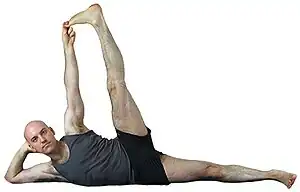 | |||
| Anjaneyasana[23] | अञ्जनेयासन | Crescent Moon[24] | Standing | Backbend | 20th C.[24] | Dragon |  | |
| Ardha Chandrasana[25] | अर्धचन्द्रासन | Half moon | Standing | 20th C. LoY[26] |  | |||
| Ashtanga Namaskara[15] | अष्टाङ्ग नमस्कार | Eight-Limbed Salutation Caterpillar |
Reclining | 20th C. TK[15] | .JPG.webp) | |||
| Astavakrasana[27] | अष्टावक्रासन | Aṣṭāvakra's pose, Eight-angled |
Balancing | 20th C. LoY[28] |  | |||
| Baddha Konasana[29] Bhadrasana[30] |
बद्धकोणासन | Bound angle, Cobbler's pose |
Sitting | Meditation[30] | 15th C. HYP[30] 17th C. GhS[30] |
Butterfly |  | |
| Bakasana[31] Kakasana[32] |
बकासन, ककासन |
Crane (arms straight) Crow (arms bent) |
Balancing | 17th C. HR[33] |  | |||
| Balasana[34] | बालासन | Child | Sitting | 20th C. TK[35] 19th C. ST Ananda Balasana (as Kandukasana)[36] |
Child's |  | ||
| Bhairavasana Ankushasana[37] |
भैरवासन अण्कुशासन |
Formidable | Reclining | 19th C. ST[37] | .jpg.webp) | |||
| Bharadvajasana[38] | भरद्वाजासन | Bharadvaja's twist | Sitting | Twist | 20th C. LoY[39] | Seated Twist | .JPG.webp) | |
| Bhekasana[40] | भेकासन | Frog | Reclining | Backbend | 20th C. LoY[41] |  | ||
| Bhujangasana[42] | भुजंगासन | Cobra | Reclining | Backbend | 17th C. GhS 2.42[43][44] | Seal, Sphinx |  | |
| Bhujapidasana[45] | भुजपीडासन | Arm-pressing posture | Balancing | 20th C. LoY[46] | Snail |  | ||
| Bidalasana[8] Marjariasana[9] |
बिडालासन मार्जरीआसन |
Cat | Kneeling | Backbend | 20th C. T.K.V. Desikachar, Satyananda Saraswati[9] |  | ||
| Chaturanga Dandasana[47] | चतुरङ्गदण्डासन | Four-Limbed Staff Low Plank |
Reclining | 20th C. TK[48] |  | |||
| Dandasana[49] | दण्डासन | Staff | Sitting | 8th C. PSV[50] |  | |||
| Dhanurasana[51] | धनुरासन | Bow | Reclining | Backbend | 15th C. HYP 1.27 |  | ||
| Durvasasana[52] | दुर्वासासन | Durvasa's Pose | Standing, Balancing | 19th C. ST (as 'Trivikramasana')[53] |  | |||
| Garbha Pindasana[54] | गर्भासन | Embryo in Womb | Sitting | 17th C. BaH[55] |  | |||
| Garudasana[56] | गरुडासन | Eagle | Standing, Balancing | 19th C. ST[57][lower-alpha 5] |  | |||
| Gomukhasana[58] | गोमुखासन | Cow-faced | Sitting | Meditation[59] | 4th C. DU 3.3–4[60][61] 7th C. AS[61] 10th C. V[62] 15th C. HYP 1.20 17th C. HR 3[63][64][61] |
Shoelace |  | |
| Gorakshasana | गोरक्षासन | Cowherd Gorakhnath's pose |
Sitting | Meditation | 14th C. ShS 3.108-112 15th C. HYP 1.28-29 17th C. GhS 2.24-25 |
.jpg.webp) | ||
| Halasana[65] | हलासन | Plough | Inversion | Forward bend | 19th C. ST[66] (as Lāṇgalāsana, plough) 20th C. TB[67] |
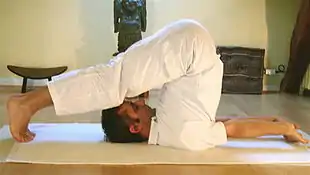 | ||
| Hanumanasana[68] | हनुमनासन | Hanuman's Pose | Sitting | 20th C. TK[69] |  | |||
| Janusirsasana[70] | जानुशीर्षासन | Head-to-Knee | Sitting | Forward Bend | 20th C. TK[71][72] |  | ||
| Jathara Parivartanasana[73] | ञटर परिवर्तनासन | Belly twist | Reclining | Twist | 20th C. LoY[73] | |||
| Kapotasana[74] | कपोतासन | Pigeon | Kneeling | Backbend | 20th C. LoY[75] |  | ||
| Karnapidasana[76] | कर्णपीडासन | Ear-pressing | Inversion | Forward bend | 20th C. TB[77] (as variant of Halasana); LoY[78] |  | ||
| Kaundinyasana[79] | कौण्डिन्यसन | Kaundinya's pose | Balancing | 20th C. LoY[80] |  | |||
| Kraunchasana[81] | क्रौञ्चासन | Heron | Sitting | 17th C. HR[33] | ||||
| Kukkutasana[54] | कुक्कुटासन | Cockerel | Balancing | 7th C. AS[55] 13th C. VS[82] 15th C. HYP 1.23 17th C. GhS 2.31[57] |
 | |||
| Kurmasana[83][84] | कूर्मासन | Tortoise | Sitting | Forward bend | 7th C. AS[55] |  | ||
| Lolasana[85] | लोलासन | Pendant | Balancing | 20th C.[lower-alpha 6][lower-alpha 7] |  | |||
| Makarasana[88] | मकरासन | Crocodile | Reclining | 17th C. GhS 2.40[lower-alpha 8] | .jpg.webp) | |||
| Malasana[90] | मालासन | Garland | Squatting | Forward bend | 20th C. LoY[90] | 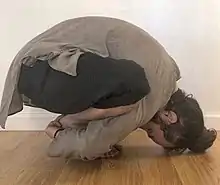 | ||
| Mandukasana | मन्दुकासन | Frog | Sitting | 17th C. GhS[43] | ||||
| Marichyasana[91] | मरीच्यासन | Marichi's Pose | Sitting | Twist | 20th C. TK[92] |  | ||
| Matsyasana[93] | मत्स्यासन | Fish | Reclining | Backbend | 17th C. GhS 2.21 | Fish |  | |
| Matsyendrasana[94] | मत्स्येन्द्रासन | Lord of the Fishes Matsyendra's pose |
Sitting | Twist | 15th C. HYP 1.28-29 17th C. GhS |
 | ||
| Mayurasana[17] | मयूरासन | Peacock | Balancing | 10th C. V[62] 15th C. HYP 1.33 |
||||
| Muktasana[6] | मुक्तासन | Liberated | Sitting | Meditation | 10th C. V[62][lower-alpha 9] |  | ||
| Natarajasana[95] | नटराजासन | Lord of the Dance Dancer Nataraja's Pose |
Standing | Backbend | 20th C. TK[96] |  | ||
| Navasana Naukasana[37] |
नावासन, परिपूर्णनावासन नौकासन |
Boat | Sitting | Forward bend | 19th C. ST[37] |  | ||
| Padmasana[97] | पद्मासन | Lotus | Sitting | Meditation[98] | 4th C. DU[99] 8th C. PSV[50] |
 | ||
| Parighasana[100] | परिघासन | Gate | Standing | 20th C. TK[48] | .jpg.webp) | |||
| Parshvakonasana[101] | पार्श्वकोणासन | Side angle | Standing | 20th C. TK[48][71] |  | |||
| Parshvottanasana[102] | पार्श्वोत्तनासन | Intense side stretch | Standing | 20th C. TK[48][71] |  | |||
| Pashasana[103] | पाशासन | Noose | Squatting | Twist | 19th C. ST[44] |  | ||
| Paschimottanasana[104] | पश्चिमोत्तानासन | Seated Forward Bend | Sitting | Forward Bend | 15th C. HYP 1:28[20] 17th C. GhS 2:26[20] |
Full Forward Bend, Caterpillar |  | |
| Pincha Mayurasana[105] | पिञ्चमयूरासन | Feathered Peacock | Balancing | 20th C. LoY[106] |  | |||
| Prasarita Padottanasana[107] | प्रसारित पादोत्तानासन | Wide Stance Forward Bend | Standing | Forward bend | 20th C. TK[48][71] | _(16383984312).jpg.webp) | ||
| Rajakapotasana[108] | राजकपोतासन | King Pigeon | Sitting | Backbend | 20th C. LoY[109] | Swan, Sleeping Swan | 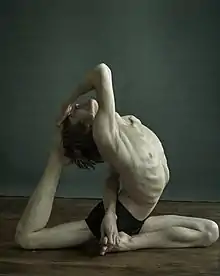 | |
| Shalabhasana[110] | शलभासन | Locust | Reclining | Backbend | 20th C. TB[111] | |||
| Sarvangasana[112] | सालम्बसर्वाङ्गासन | Shoulder Stand | Inversion | 20th C. (this name); 19th C. as Viparita Karani in JP; 15th C. HYP |  | |||
| Samakonasana[113] | समकोणासन | Side splits | Sitting | 20th C. TK[71] | _Szpagat_poprzeczny.jpg.webp) | |||
| Shavasana[114] | शवासन | Corpse | Reclining | 15th C. HYP 1.32[115] | Corpse |  | ||
| Setu Bandha Sarvangasana[116] | सेतुबन्धसर्वाङ्गासन | Shoulder supported bridge | Inversion | Backbend | 19th C. ST, called Kāmapīṭhāsana[117] | _from_Sritattvanidhi.jpg.webp) | ||
| Siddhasana (men), Siddha Yoni Asana (women)[118] |
सिद्धासन | Accomplished, The Adept's Pose |
Sitting | Meditation[118] | 10th C. GS 1.10-12 | 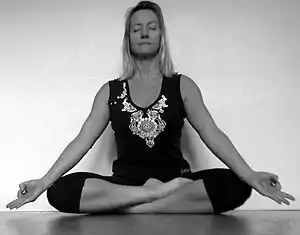 | ||
| Simhasana[119] | सिंहासन | Lion | Sitting | Meditation[119] | 4th C. DU[99] 10th C. V[62] |
 | ||
| Shirshasana[120] Kapalasana[121] |
शीर्षासन | Headstand, Yoga Headstand |
Inversion | 11th C. HY[122](called Duryodhanāsana or Kapālīkarana) 14th C. ShS 4.45-47 (as Viparita Karani)[123] 15th C. HYP 3.78-81 (ditto)[123] 17th C. GhS 3.33-35 (ditto)[123] 18th C. JP (as Kapala āsana) |
 | |||
| Sukhasana[124] | सुखासन | Easy | Sitting | Meditation[125] | 4th C. DU[126] | Easy |  | |
| Supta Padangusthasana[127] | सुप्त पादाङ्गुष्ठासन | Big toe supine | Reclining | 20th C. TK[48][71] |  | |||
| Surya Namaskar[128][129] | सुर्य नमस्कार | Salute to the Sun Sun Salutation |
Standing | Forward bend, backbend sequence |
20th C. Rajah of Aundh,[130] then TK[15] |  | ||
| Svastikasana[131] | स्वस्तिकसन | Auspicious Lucky mark |
Sitting | Meditation[131] | 8th C. PSV[50] | Square | .jpg.webp) | |
| Tadasana[132] | ताडासन | Mountain | Standing | 20th C. TK[48] | ||||
| Tittibhasana[133] | टिट्टिभासन | Firefly | Balancing | 19th C. ST[44] (as Mālāsana) |  | |||
| Trikonasana, Utthita Trikonasana[134] |
त्रिकोणासन, उत्थित त्रिकोणासन |
Triangle | Standing | 20th C. TK[135] |  | |||
| Trivikramasana[136] | त्रिविक्रमासन | Trivikrama's pose Standing splits Supta Trivikramasana (reclining variant) |
Standing, Balancing | 13th - 18th C. in Bharatnatyam dance statues of Eastern Gopuram, Nataraja Temple, Chidambaram[137] |  | |||
| Tulasana[138] | तुलासन | Balance / Scales | Balancing | 20th C. LoY[139] |  | |||
| Upavishta Konasana[140] | उपविष्टकोणासन | Open Angle | Sitting | 20th C. TK[71] | Dragonfly |  | ||
| Urdhva Dhanurasana[141] Chakrasana |
ऊर्ध्वधनुरासन, चक्रासन | Upwards-facing bow, Wheel |
Inversion | Backbend | 19th C. ST[142] (as Paryaṇkāsana) |  | ||
| Urdhva Mukha Shvanasana[143] | ऊर्ध्वमुखश्वानासन | Upward-Facing Dog | Reclining | Backbend | 20th C. TK[48] |  | ||
| Ushtrasana[144] | उष्ट्रासन | Camel | Kneeling | Backbend | 20th C. LoY[145] |  | ||
| Utkatasana[146] | उत्कटासन | Awkward or Powerful | Standing | 15th C. HYP (squatting)[147] 17th C. GhS[43] 20th C. TK[148] (chair-like) |
 | |||
| Uttanasana[149] | उत्तानासन | Standing Forward Bend | Standing | Forward bend | 20th C. TB (as Padahastasana)[150]; TK[48][71] |  | ||
| Utthita Hastapadangusthasana[151] | उत्थित हस्तपादाङ्गुष्ठासन | Standing Big Toe Hold (I: leg to the side; II: leg to the front[151]) |
Standing | 20th C. TK[48][71] |  | |||
| Vajrasana[152] | वज्रासन | Thunderbolt | Kneeling | Meditation[153] | 17th C. GhS[43] (may mean Virasana[115]) |  | ||
| Vasishtasana[154] | वसिष्ठासन | Vasishta's pose, Side plank |
Balancing | 20th C. TK[155] |  | |||
| Viparita Dandasana[156] | विपरीत दण्डासन | Inverted Staff | Inversion | Backbend | 20th C. TK?, LoY[156] | 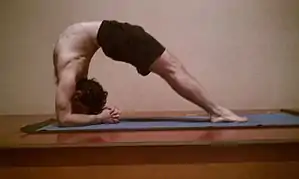 | ||
| Viparita Karani[157] Uttanapadasana (variant) |
विपरीतकरणि | Inverted practice Legs up the wall |
Inversion | 13th C. VM for pratyahara[158] 14th C. ShS 4.45-47[123] 15th C. HYP 3.78-81[123] 17th C. GhS 3.33-35[123] and other texts[135][lower-alpha 10] |
Legs-Up-the-Wall |  | ||
| Viparita Virabhadrasana[159] | विपरीतवीरभद्रासन | Reversed Warrior[lower-alpha 11] | Standing | 21st C. PL[159] |  | |||
| Virabhadrasana I[160] | वीरभद्रासन | Warrior I | Standing | 20th C. TK[161][162] |  | |||
| Virabhadrasana II[163] | वीरभद्रासन II | Warrior II | Standing | 20th C. TK[161][162] |  | |||
| Virabhadrasana III[164] | वीरभद्रासन III | Warrior III | Standing | 20th C. TK[161][162] |  | |||
| Virasana,[165] Dhyana Virasana[166] |
वीरासन, ध्यान वीरासन |
Hero, Hero's Meditation |
Kneeling | Meditation[166][167] | 4th C. DU[99] 8th C. PSV[50] (these may refer to a different meditation pose) |
 | ||
| Vrikshasana[168] | वृक्षासन | Tree | Standing, Balancing | 17th C. GhS[43] |  | |||
| Vrischikasana[169] | वृश्चिकासन | Scorpion | Inversion | Backbend | 20th C. LoY[170] (13th - 18th C. in Bharatnatyam dance statues of Eastern Gopuram, Nataraja Temple, Chidambaram but not yoga[137]) |  | ||
| Yoganidrasana[171] Pasini Mudra |
योगनिद्रासन | Yogic sleep Noose Mudra |
Reclining | Forward bend | 17th C. HR 3.70 17th C. GhS 3.84 as a Mudra 18th C. painting, Mysore[172] |
 |
See also
- Mudra – yoga gestures
- Pranayama – yoga breathing techniques
- Surya Namaskar – a foundational sequence of asanas
Notes
- 84's symbolism may derive from its astrological and numerological properties: it is the product of 7, the number of planets in astrology, and 12, the number of signs of the zodiac, while in numerology, 7 is the sum of 3 and 4, and 12 is the product, i.e. 84 is (3+4)×(3×4).[4]
- PL, Post-Light on Yoga poses, are marked as '21st C.' to sort late 20th as well as 21st century asanas after TK and LoY.
- Sjoman notes that the names of asanas have been used "promiscuous[ly]", making their history difficult to trace: the presence of matching names is not proof of continuity, since the same name may mean a different pose, and a pose may have been known by other names at different times.[5] The dates here are therefore based on documents which provide actual descriptions of the asanas.
- The Yin Yoga variants are similar but not identical to their 'Yang' equivalents.[13]
- GhS uses the name Garuḍāsana for a different pose.
- Not yet yoga in 1896 as Jhūla pose in Vyayama Dipika gymnastics book[86]
- LoY has the legs as in Gomukhasana, not in Padmasana.[87]
- LoY quotes and interprets GhS 2.40 as meaning a variant of Salabhasana, the legs stretched out and raised, the arms as GhS states on the head, also raised;[89] Saraswati has the head supported with elbows on the ground;[88]a a widespread modern form has feet and head on the ground.
- Several sitting meditation poses have been called Muktasana.
- Viparita Karani is an inverted practice rather than an asana; the ShS, HYP and GhS descriptions suggest the actual posture used was a headstand.
- This is a well-documented example of a post-Light on Yoga (1966) pose, created as a variation of the 20th century Warrior poses. Hundreds of less common variations of other poses have been created in the same time frame.
References
- Singleton 2010, pp. 4–5.
- Murugan 2012.
- Bühnemann, Gudrun (2007). Eighty-Four Asanas in Yoga: A Survey of Traditions. New Delhi: D. K. Printworld. pp. 47, 151. ISBN 978-8124604175.
- Rosen, Richard (2017). Yoga FAQ: Almost Everything You Need to Know about Yoga-from Asanas to Yamas. Shambhala. pp. 171–. ISBN 978-0-8348-4057-7.
- Sjoman 1999, p. 59.
- "Muktasana". Yogapedia. Retrieved 23 November 2018.
- Sjoman 1999, p. 57.
- Lidell 1983, p. 166.
- "Cat Pose – Marjariasana". Akasha Yoga. Retrieved 13 January 2019.
- Iyengar 1979, pp. 179–205.
- McCrary, Meagan (15 July 2015). "#YJ40: 10 Poses Younger Than Yoga Journal". Yoga Journal.
Once you learn how the fundamental poses work anatomically then it's very natural to start to play with breaking them apart and putting them back together differently ... You won't find this playful variation of Warrior II Pose in Light on Yoga.
- Mallinson & Singleton 2017, p. xxxix.
- Powers 2008, p. 195.
- Mehta, Mehta & Mehta 1990, p. 147.
- Singleton 2010, pp. 205–206.
- Mallinson & Singleton 2017, p. 125.
- Lidell 1983, p. 142.
- Mallinson & Singleton 2017, p. 124.
- Saraswati 1996, p. 137.
- Sjoman 1999, p. 84.
- Mehta, Mehta & Mehta 1990, p. 87.
- Iyengar 1979, pp. 246–247.
- Steiner, Ronald (June 2015). "Anjaneyāsana - Learning devotion from Hanuman". Yoga Aktuell (in German) (92 June/July 2015). Retrieved 23 January 2019.
- Lidell 1983, pp. 132–133.
- Mehta, Mehta & Mehta 1990, p. 30.
- Iyengar 1979, pp. 74–76.
- Mehta, Mehta & Mehta 1990, p. 128.
- Iyengar 1979, pp. 276–278.
- Mehta, Mehta & Mehta 1990, p. 57.
- "How to do Bhadrasana?". The Yoga Institute. 3 August 2018. Retrieved 5 January 2019.
- Mehta, Mehta & Mehta 1990, p. 130.
- Lidell 1983, p. 60.
- Srinivasa 2002, pp. 98–122 asanas listed, Figures of asanas in unnumbered pages between pages 153 and 154, asanas named but not described in text listed on pages 157–159.
- Lidell 1983, p. 39.
- "Balasana - Child Pose". Akasha Yoga. Retrieved 13 January 2019.
- Sjoman 1999, pp. 15, 70, plate 1 (pose 6).
- Sjoman 1999, p. 69.
- Mehta, Mehta & Mehta 1990, p. 77.
- Iyengar 1979, pp. 251–254.
- Mehta, Mehta & Mehta 1990, p. 86.
- Iyengar 1979, pp. 126–128.
- Mehta, Mehta & Mehta 1990, p. 93.
- Mallinson 2004, pp. 16–17.
- Sjoman 1999, p. 76.
- Mehta, Mehta & Mehta 1990, p. 129.
- Iyengar 1979, pp. 280–282.
- Mehta, Mehta & Mehta 1990, p. 89.
- Singleton 2010, pp. 204–205.
- Mehta, Mehta & Mehta 1990, p. 52.
- Mallinson & Singleton 2017, pp. 97–99.
- Mehta, Mehta & Mehta 1990, p. 94.
- Iyengar 1979, pp. 299–302.
- Sjoman 1999, p. 78.
- Lidell 1983, pp. 136–137.
- Mallinson, James (9 December 2011). "A Response to Mark Singleton's Yoga Body by JamesMallinson". Retrieved 4 January 2019. revised from American Academy of Religions conference, San Francisco, 19 November 2011.
- Mehta, Mehta & Mehta 1990, p. 46.
- Sjoman 1999, p. 75.
- Mehta, Mehta & Mehta 1990, p. 56.
- "Gomukhasana (Cow Face Posture)". The Divine Life Society. 2011. Retrieved 28 January 2019.
Hence, this Asana is suitable for the practice of Pranayama. Ordinarily you can sit at all times in this Asana for long meditation also.
- Ayyangar 1938, p. 124.
- Sriharisukesh & Pailoor 2019, pp. 270–273.
- Mallinson & Singleton 2017, pp. 100–101.
- Srinivasa 2002.
- Mallinson & Singleton 2017, pp. 116–119.
- Mehta, Mehta & Mehta 1990, p. 110.
- Sjoman 1999, p. 72.
- Bernard 2007, p. 110.
- Saraswati 1996, p. 340.
- Singleton 2010, pp. 60–63.
- Mehta, Mehta & Mehta 1990, p. 59.
- Sjoman 1999, p. 49.
- "Head to Knee Pose – Janushirshasana". Akasha Yoga. Retrieved 13 January 2019.
- Iyengar 1979, pp. 237–240.
- Mehta, Mehta & Mehta 1990, p. 144.
- Iyengar 1979, pp. 367–372.
- Mehta, Mehta & Mehta 1990, p. 112.
- Bernard 2007, p. 111.
- Iyengar 1979, pp. 220–221.
- Iyengar 1979, p. 276.
- Iyengar 1979, pp. 330–336.
- Mehta, Mehta & Mehta 1990, p. 62.
- Mallinson & Singleton 2017, pp. 104–105.
- Mehta, Mehta & Mehta 1990, p. 68.
- Lidell 1983, p. 120.
- Mehta, Mehta & Mehta 1990, p. 124.
- Sjoman 1999, p. 55.
- Iyengar 1979, pp. 116.
- Saraswati 1996, p. 90.
- Iyengar 1979, pp. 100–101.
- Iyengar 1979, pp. 262–267.
- Mehta, Mehta & Mehta 1990, pp. 63, 70, 73.
- Krishnamacharya 2006, p. 115.
- Mehta, Mehta & Mehta 1990, p. 83.
- Saraswati 1996, p. 326.
- Lidell 1983, p. 149.
- Goldberg 2016, p. 223.
- Mehta, Mehta & Mehta 1990, p. 54.
- Saraswati 1996, p. 98.
- Ayyangar 1938, pp. 124–127.
- Mehta, Mehta & Mehta 1990, p. 48.
- Mehta, Mehta & Mehta 1990, pp. 24–25.
- Mehta, Mehta & Mehta 1990, p. 40.
- (no byline) (28 August 2007). "Noose Pose". Yoga Journal. Retrieved 11 November 2018.
- Mehta, Mehta & Mehta 1990, p. 64.
- Mehta, Mehta & Mehta 1990, p. 97.
- Iyengar 1979, pp. 285–287.
- Mehta, Mehta & Mehta 1990, p. 42.
- Mehta, Mehta & Mehta 1990, p. 143.
- Iyengar 1979, pp. 389–397.
- Mehta, Mehta & Mehta 1990, p. 92.
- Bernard 2007, p. 114.
- Mehta, Mehta & Mehta 1990, pp. 111–115.
- Saraswati 1996, p. 149.
- Mehta, Mehta & Mehta 1990, p. 150.
- Sjoman 1999, p. 79.
- Mehta, Mehta & Mehta 1990, pp. 116, 120–121.
- Sjoman 1999, p. Plate 14.
- Saraswati 1996, pp. 100–103.
- Saraswati 1996, pp. 106–107.
- Mehta, Mehta & Mehta 1990, p. 98.
- Sjoman 1999, p. 74.
- Mallinson & Singleton 2017, p. 104.
- Bernard 2007, p. 29.
- Mehta, Mehta & Mehta 1990, p. 53.
- Saraswati 1996, p. 96.
- Larson & Bhattacharya 2008, pp. 479, 599.
- Mehta, Mehta & Mehta 1990, p. 88.
- Mehta, Mehta & Mehta 1990, pp. 146–147.
- Lidell 1983, pp. 34–35.
- Doctor, Vikram (15 June 2018). "Bhawanrao Shrinivasrao Pant Pratinidhi: The man who promoted Surya Namaskar". The Economic Times (India).
- Saraswati 1996, pp. 103–104.
- Mehta, Mehta & Mehta 1990, p. 18.
- Iyengar 1979, pp. 308–309.
- Mehta, Mehta & Mehta 1990, p. 22.
- Mallinson & Singleton 2017, p. 90.
- Iyengar 1979, pp. 356–357.
- Bhavanani, Ananda Balayogi; Bhavanani, Devasena (2001). "Bharatanatyam and Yoga". Archived from the original on 23 October 2006.
- Ezraty, Maty (2002). "Asana". Yoga Journal (January/February): 116–128.
- Iyengar 1979, pp. 134–135.
- Mehta, Mehta & Mehta 1990, p. 65.
- Mehta, Mehta & Mehta 1990, p. 138.
- Sjoman 1999, p. 70.
- Mehta, Mehta & Mehta 1990, p. 91.
- Mehta, Mehta & Mehta 1990, pp. 134–135.
- Iyengar 1979, pp. 87–88.
- Mehta, Mehta & Mehta 1990, p. 47.
- Sjoman 1999, pp. 40–41, plate 17.
- "Utkatasana | Chair Pose". Akasha Yoga Academy. Retrieved 1 January 2019.
- Mehta, Mehta & Mehta 1990, p. 44.
- Bernard 2007, p. 132.
- Mehta, Mehta & Mehta 1990, p. 20.
- Saraswati 1996, p. 109.
- "Sitting Postures for Pranayama and Meditation". Yoga in Daily Life. Retrieved 16 November 2018.
- Mehta, Mehta & Mehta 1990, pp. 126–127.
- Singleton 2010, pp. 200–205.
- Iyengar 1979, pp. 373–379.
- Mehta, Mehta & Mehta 1990, p. 122.
- Westoby, Ruth (October 2019). "The Viveka-mārtaṇḍa on pratyāhāra in viparītakaraṇī with James Mallinson". SOAS, University of London. Retrieved 14 November 2020.
- McCrary, Meagan (15 July 2015). "#YJ40: 10 Poses Younger Than Yoga Journal". Yoga Journal.
Reverse Warrior | You won't find this playful variation of Warrior II Pose in Light on Yoga.
- Mehta, Mehta & Mehta 1990, p. 26.
- "Virabhadrasana or Warrior Pose". Bahiranga.com. 2 August 2016. Retrieved 11 January 2019.
- Singleton 2010, p. 161.
- Mehta, Mehta & Mehta 1990, p. 28.
- Mehta, Mehta & Mehta 1990, p. 32.
- Mehta, Mehta & Mehta 1990, p. 50.
- Saraswati 1996, p. 105.
- Crandell, Jason (28 August 2007). "You Don't Have to Play Martyr in Hero Pose". Yoga Journal. Retrieved 16 November 2018.
- Mehta, Mehta & Mehta 1990, p. 21.
- Lidell 1983, p. 104.
- Iyengar 1979, pp. 386–388.
- Iyengar 1979, pp. 304–307.
- Sjoman 1999, p. 13.
Sources
- Ayyangar, T. R. Srinivasa (trans.) (1938). The Yoga Upanishads. Adyar, Madras: The Adyar Library.
- Bernard, Theos (2007) [1944]. Hatha yoga : the report of a personal experience. Edinburgh: Harmony. ISBN 978-0-9552412-2-2. OCLC 230987898.
- Goldberg, Elliott (2016). The Path of Modern Yoga : the history of an embodied spiritual practice. Rochester, Vermont: Inner Traditions. ISBN 978-1-62055-567-5. OCLC 926062252.
- Iyengar, B. K. S. (1979) [1966]. Light on Yoga: Yoga Dipika. Thorsons. ISBN 978-1855381667.
- Krishnamacharya, Tirumalai (2006) [1934]. Yoga Makaranda. Translated by Lakshmi Ranganathan; Nandini Ranganathan.
- Larson, Gerald James; Bhattacharya, Ram Shankar (2008). Yoga : India's Philosophy of Meditation. Motilal Banarsidass. ISBN 978-81-208-3349-4.
- Lidell, Lucy, The Sivananda Yoga Centre (1983). The book of yoga. Ebury. ISBN 978-0-85223-297-2. OCLC 12457963.
{{cite book}}: CS1 maint: multiple names: authors list (link) - Mallinson, James (2004). The Gheranda Samhita: the original Sanskrit and an English translation. YogaVidya. ISBN 978-0-9716466-3-6.
- Mallinson, James; Singleton, Mark (2017). Roots of Yoga. Penguin Classics. London: Penguin Books. ISBN 978-0-241-25304-5. OCLC 928480104.
- Mehta, Silva; Mehta, Mira; Mehta, Shyam (1990). Yoga: The Iyengar Way. Dorling Kindersley. ISBN 978-0863184208.
- Murugan, Chillayah (20 October 2012). "Yoga Asanas for Health and Fitness". Silambam. Archived from the original on 3 October 2015. Retrieved 31 May 2013.
- Powers, Sarah (2008). Insight Yoga. Shambhala. ISBN 978-1-59030-598-0. OCLC 216937520.
- Saraswati, Swami Satyananda (1996). Asana Pranayama Mudra Bandha (PDF). Yoga Publications Trust. ISBN 978-8186336144. Archived from the original (PDF) on 2015-08-07. Retrieved 2018-11-10.
- Sriharisukesh, N.; Pailoor, Subramanya (2019). "A review of asanas referenced in ancient texts and a brief comparative study of selected asanas" (PDF). International Journal of Sanskrit Research. 5 (4). ISSN 2394-7519.
- Srinivasa, Narinder (2002). Gharote, M. L.; Devnath, Parimal; Jha, Vijay Kant (eds.). Hatha Ratnavali Srinivasayogi | A Treatise On Hathayoga (1st ed.). Lonavla, India: The Lonavla Yoga Institute. ISBN 81-901176-96.
- Singleton, Mark (2010). Yoga Body : the origins of modern posture practice. Oxford University Press. ISBN 978-0-19-539534-1. OCLC 318191988.
- Sjoman, Norman E. (1999). The Yoga Tradition of the Mysore Palace. Abhinav Publications. ISBN 81-7017-389-2.
_from_Jogapradipika_1830_(cropped).jpg.webp)